Table of contents
- Rear silencer – look at the legal situation (2018) EU homologation of exhausts
- Clear advantages in terms of weight
- Introduction of Euro 5b in 2024
- Driving noises according to Euro 4
- EC type approval process
- Okay for the street, too loud for the racetrack?
- Interview with Paul Lohmar (TuV Rheinland)
- Interview with Christoph Gatzweiler (IVM)

Lohse
counselor
traffic & business
Rear muffler accessories-exhaust homologation legal situation 2018
Rear silencer – look at the legal situation (2018)
EU homologation of exhausts
First there were slack limit values, then test methods that were far from everyday life. In times of increasing noise levels, the motorcycle is once again the focus. Right? A look at the current legal situation, the noise measurements and the EC type approval test for rear silencers provide the first information.
Roman Kirschbauer
10/25/2018
The new motorcycle is finally in the yard, the driver grins happily next to the virgin lover. But before the first bursts of gas hit the engine and set the marrow and bone vibrating, you have to screw it up. After all, the standard exhaust patters much too well, and the object of desire has been in the garage for days, eagerly waiting to be used. Whether that’s exactly how it works in reality or just roughly: The majority of motorcycle owners swap the original rear silencer for an accessory. Apart from the sound, this is due to the weight and appearance. Chunky standard silencers make the wiry bike unnecessarily chubby, and in some cases weigh a lot according to their appearance.
Buy complete article
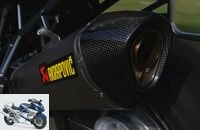
Rear silencer – look at the legal situation (2018)
EU homologation of exhausts
4 pages) as PDF
€ 2.00
Buy now
Clear advantages in terms of weight
Even today, many two-wheelers believe that the better and sometimes louder sound has a positive effect on the performance of the motorcycle. Not so long ago, even before the use of bread box-like front silencers, catalytic converters and lambda sensors, this was the case with high-quality systems. For example, in 2009 an accessory exhaust system increased the peak performance of a Suzuki Bandit 1250 by six hp and three Newton meters – not uncommon. However, as MOTORRAD’s tests in recent years have shown, some manufacturers still advertise small increases in performance for slip-on mufflers, but in fact they often only just barely achieve series performance. When you look at the scales, however, they offer clear advantages, but the reasons for buying an accessory exhaust are largely due to the better sound. And unfortunately, “better” sometimes also means louder here.
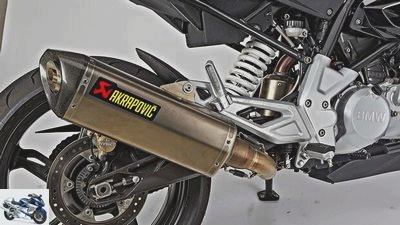
mps photo studio
Accessory exhaust systems such as this silencer from Akrapovic often bring enormous weight advantages.
How can that actually be when the test procedures are supposed to prevent that? Brief review: New motorcycles have had to comply with the Euro 4 regulations since 01.01.2016 in order to obtain an EC type approval. This can be found in the finest bureaucracy German in the 77-page EU regulation with the number 168/2013. The complex test procedure only applies to new motorcycles and corresponding accessory mufflers, but not fundamentally for all accessory mufflers. In the case of specimens for older motorcycles, the noise measurement valid at the time the vehicle was first registered is used as a basis. This is technically understandable. A motorcycle that was homologated according to Euro 3 in 2009 cannot suddenly be confronted with Euro 4 standards because of the replacement of the rear silencer. On the one hand. On the other hand, it has to be stated that the unpleasant flap systems due to the vague formulations in Regulation 168/2013 have not completely disappeared from the streetscape even with new vehicles and the noise level outside the measuring ranges is increasing rapidly. Ergo: Whoever turns on the shower will be (too) audible even with Euro 4 vehicles. The driver is particularly responsible here.
Introduction of Euro 5b in 2024
That leaves the matter of the accessory exhausts. Because if such a device has been tested by a national approval authority in accordance with European law and an EC type approval has been issued, there is no direct action by other approval authorities or test institutes to revoke it if it is determined that the rear silencer does not (no longer) comply with the limit values. The situation gets a bland aftertaste from the fact that the testing authorities are in economic competition with one another. You benefit when numerous manufacturers apply to them for an EC type-approval procedure. Also noticeable: motorcycles such as accessory exhausts are particularly popular in certain EU countries.

technology & future
Tuning special – exhaust systems
New tones
read more
It is undisputed that the acceptance of motorcycles and their drivers will not increase unless the applicable regulations are consistently applied. The previous practices seem to be in the interests of neither residents of popular motorcycle routes nor motorcyclists. Hopefully the pendulum will not swing back completely with the introduction of Euro 5b in 2024.
Driving noises according to Euro 4
The distance: 20 meters. The speed: between 30 and 70 km / h. In this area, the legally relevant driving noises for the motorcycle are determined. At the end there has to be a decibel value that corresponds to little more than the noise of the wind on the ear.
It is no easy exercise to determine the legally relevant driving noises according to UNECE-R41. Gone are the days when people were generally lumped together. For each motorcycle there are now individual specifications that must also be attached to the vehicle. Our sample vehicle is registered with 75 dB (A) according to the registration documents. This decibel figure, which is referred to as L (urban), i.e. more or less the noise value for urban traffic, cannot simply be measured. Our graphic illustrates the complexity of the new noise test method.
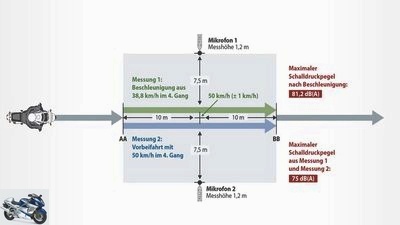
MOTORCYCLE
Explanatory diagram for determining the driving noises.
In the case of the sample bike, on the one hand, the accelerated drive past with an initial speed of 38.8 km / h in fourth gear over the 20-meter-long measurement section. When passing the AA line, the throttle grip is fully opened, at BB it is closed again. Important: When passing the center line (where the microphones are also positioned), the speed must be 50 km / h. This requirement is the same for all motorcycles, which is why it is now understandable that individual output values (speed, gear step) apply depending on the acceleration capacity of the respective bike. The maximum permissible decibel value, referred to as L (wot) in the acceleration measurement, is 81.2 dB (A) in the case of the model motorcycle. In order to determine L (urban), the second test point is still missing: driving through the same gear at 50 km / h. Taking into account a motorcycle-dependent partial load factor, the constant sound pressure level L (crs) and the acceleration value L (wot) are calculated using a formula. the driving noise L (urban). understood?
EC type approval process
The norms and guidelines that have to be complied with are mainly regulated by EU law. Here it is even based on partially uniform standards set by the UN, the UNECE-R41. This is implemented in EU regulation 168/2013.
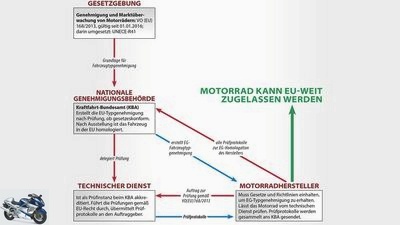
MOTORCYCLE
The EC type-approval process is a long process.
The national approval authority, in Germany the Federal Motor Transport Authority (KBA), monitors compliance. If a manufacturer wants to homologate a new vehicle, it has to go through appropriate tests after an initial assessment by the KBA. The test reports are collected by the motorcycle manufacturer and attached to the application for an EC type approval. The KBA examines the application and issues the approval. The vehicle can now be registered in the entire EU.
Okay for the street, too loud for the racetrack?
There are also limits for the noise emissions of motorcycles in some cases on race tracks. Depending on the route, these are mostly around 100 decibels.
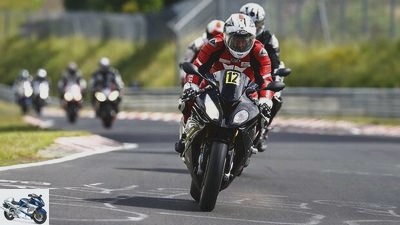
www.r-photography.info
As here at the Nurburgring, noise limits also apply on other racetracks.
The curious thing: There are current motorcycles that exceed this limit value with the standard exhaust system and free of any manipulation. The result: These bikes are not allowed on the slopes, but can be brought home legally and without restrictions on the country road. At the Sachsenring, people and owners of these bikes help themselves with special noise control systems: The exhaust openings are “directed away” from the measuring station.
Interview with Paul Lohmar (TuV Rheinland)
Paul Lohmar is an expert in the homologation of motor vehicles at TuV Rheinland. In an interview with MOTORRAD, he made it clear that the current test methods leave no room for interpretation.
Is the test of replacement silencers identical to the Euro 4 regulations that the manufacturer must meet in order to obtain an EC type approval for a vehicle??
Yes, the regulations (Regulation (EU) 134/2014 / UNECE-R 41.04) are the same as for the homologation of an entire vehicle. The individual test steps (accelerated drive past, constant drive past, ASEP) and exhaust gas behavior must also be fulfilled by the respective replacement silencer. This may be a maximum of 3 dB above the type-tested stationary noise value and 1 dB above the currently valid driving noise limit value. The replacement silencer must not be higher than the values of the standard silencer, but must be lower or the same.
What exactly does the ASEP measurement look like??
In this test, various “driving modes” or settings on the motorcycle are checked. Furthermore, tests are carried out in different gear stages (e.g. 2nd / 3rd / 4th gear). The entry and exit speeds and the exact speed of the vehicle must be taken into account. Using a formula, with the help of the nominal speed, idling speed and the PMR (power-to-mass ratio index), parameters are calculated that the vehicle must comply with at the end and / or at the beginning of the noise measurement section. The exit speed on the measuring section must not exceed 80 km / h.
Wonder how some of the accessory systems on the market could ever receive an EC type approval?
At TuV Rheinland, we strictly adhere to the requirements of the ordinances, rules and guidelines of the EU as well as national regulations. The problem is that nobody can exactly determine whether a silencer that was presented to a technical service for inspection is also the one that can later be found in the store. Regulation VO (EU) 134/2014 provides precise information on checking replacement silencer systems on the market. However, the approval authorities check their conformity far too seldom. Black sheep in the industry can be so badly exposed. Renowned manufacturers have ever greater problems with this.
Interview with Christoph Gatzweiler (IVM)
Christoph Gatzweiler, Head of Technology at the German Motorcycle Industry Association (IVM), on the current debate about accessory rear silencers and the negotiations for the introduction of Euro 5a and 5b.
How do you explain that a not inconsiderable number of homologated accessory exhaust systems do not comply with the limit values? It has to do with the EU member state in which the EC type approval was obtained?
There is no plausible explanation for this. When an authority grants an approval, it should also ensure that the products placed on the market subsequently comply with the regulations. Otherwise the type approval procedure makes no sense.
What will change in the specifications if the UNECE-R92, which was updated and adopted by the UN in March 2017, is transferred into European legislation??
The regulations for the replacement silencers have been adapted to those for the vehicle and, after formal implementation of this adaptation, could also be used again for vehicles from Euro 4.

Schumann
Christoph Gatzweiler is head of technology at the German Motorcycle Industry Association (IVM)
The motorcycle manufacturers have an interest in the broad acceptance of motorcycles in the population. Are there any initiatives on the part of the IVM or the European industrial association ACEM to reduce the noise level from motorcycles??
You don’t even need to take your own initiative here. Negotiations on Euro 5 are currently taking place. The noise emissions are on the agenda. The discussions about the new requirements for Euro 5 are in full swing.
With Euro 5, the topic of new motorcycles and noise is taken up again. We are not yet aware of any limit values for 2020, when Euro 5a is to start. And you?
The official draft of the European Commission does not yet provide for any new limit values for noise in 2020. The feasibility study for new requirements was completed far too late. In addition, the remaining 16 months as a lead time for comprehensive technical changes would be a little too short-term. The topic of noise can only be dealt with in the second step.
Even if the new limit values with Euro 5b should not take effect until 2024: The motorcycles coming onto the market are already being developed now. Is the schedule getting tight here??
That actually depends on the scope of the changes or the tightening of the requirements and on when the industry will have a final and legally binding submission of the innovations. It is not just individual models that are affected, but the entire model range must be adapted. In addition, far-reaching changes in vehicle technology are usually necessary to reduce noise.
Which improvements to UNECE-R 41 (which was implemented with Euro 4) are currently the most likely?
It will primarily concern the so-called ASEP part (Additional Sound Emission Provisions), which should cover the range of operating states of the motorcycle (for an explanation see interview with Paul Lohmar, editor’s note). A lowering of the general limit value is also expected.
What kind of noise measurement process could you imagine?
Basically, the chosen path to cover more operating states is the right approach. However, this is much more complex with noise than with exhaust. The exhaust gas can be determined wonderfully with a realistic cycle on a roller test bench. Anyone who has ever been to such a test stand knows that individual noises can no longer be measured here. The ventilation of the test stand, the fans for vehicle cooling, fast-running metal rollers and the multiple reflections of the noises prevent any reasonable measurement. To do this, you have to get some fresh air. The basic approach of the current UNECE-R 41 therefore seems to me to be the right way to go.
In addition to the noise limit values, catalyst monitoring will probably also be an issue again in Euro 5b. What is it and what is the purpose of it?
With catalyst monitoring, both the inflow and the outflow of the exhaust gases are monitored by a lambda probe. In this way the effectiveness of the catalytic converter can be measured. However, due to the short exhaust systems on two-wheelers, there are a few technical problems that have yet to be solved.
Related articles
-
Legal basis for motorcycle conversions
Fotalia 15th pictures Fotalia 1/15 Legal basis for the self-made custom bike. Ralf Petersen 2/15 First desk, then workbench. Nothing works without…
-
Product test: accessory silencer for BMW S 1000 RR
Photos: BMW accesories Exhaust & silencer Product test: accessory silencer for BMW S 1000 RR Product test: exhaust systems for BMW S 1000 RR What do…
-
EU type approval: motorcycles, trikes, quads
fact 9 pictures Bilski 1/9 The motorcycle license is not only a permit to drive on public premises, but also for many people the ticket to freedom. To…
-
Accessory silencer for BMW R nineT Urban G-S
Yvonne Hertler, Lohse 14th pictures Yvonne Hertler, Lohse 1/14 Five silencers undergoing a tough performance and noise check. Yvonne Hertler, Lohse 2/14…
-
Euro 5 for motorcycles from 2020
Katrin Sdun counselor traffic & business Euro 5 for motorcycles from 2020 Euro 5 for motorcycles from 2020 First exhaust gas values, then OBD II and…
-
New noise regulation for motorcycles from 2016
Motorcycle noise Debate about the volume of motorcycles Photo: fact 8th pictures Chaqune 1/8 Moto Guzzi driver Holger Siegel is the spokesman for the…
-
Manufacturer statements on the subject of motorcycle noise
Motorcycle noise Debate about the volume of motorcycles Astrid Gast – stock.adobe.com counselor traffic & business Manufacturer statements on the subject…
-
Bilski accesories Exhaust & silencer Exhaust test Kawasaki Z 750 Exhaust test Kawasaki Z 750 Listening games Does the Kawasaki Z 750 sound better or just…
-
Hertneck accesories Exhaust & silencer Exhaust test BMW K 1200 S Exhaust test BMW K 1200 S Investment advice When it comes to top performance, there is…
-
Accessory silencer for the BMW F 800 R in a comparison test
Jorg Lohse 21 pictures Jorg Lohse 1/21 Thanks to Euro 4, a new noise directive will come into effect from January 2017 at the latest. In the future, the…